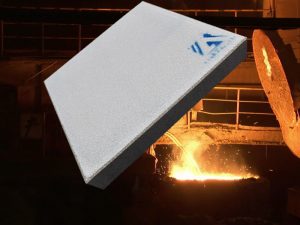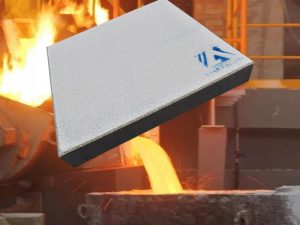Classification of launder systems
According to the structure, the launder system is divided into a straight flow slot, an oblique flow slot, a split flow slot, a corner flow slot, a lifting flow slot, etc., and they cooperate with each other to make the induction melting furnace and the casting platform. The aluminum melt is conveyed smoothly.
The DC tank is one of the most common flow cells among all flow cells. It has a simple structure and is easy to manufacture, and is suitable for long-distance aluminum liquid transportation. Early manufacturers designed the length of the DC slot to be more than 1000 mm, which is difficult to transport and install and easily damaged. Later, with the development of high-temperature inorganic binders, manufacturers reduced the length of the launder systems as much as possible, and controlled them to be less than 500 mm, and then used inorganic high-temperature binders to achieve seamless splicing, which cost all transportation, installation, and replacement costs. has improved. The structure of the DC tank is shown in Figure 1.
The inclined flow trough is installed at the molten aluminum inlet of the casting platform and the molten aluminum delivery outlet and is used for the connection between the molten aluminum on the platform and the oblique opening of the molten aluminum delivered from the smelting furnace. It is easy to use splicing butt joints, and the precision requirements of splicing are not high. The inclined flow groove generally adopts 45 °
Angle sloping. As shown in Figure 2
The distribution tank is mainly installed on the casting platform or the aluminum liquid conveying device. When the aluminum liquid of one melting furnace supplies two casting equipment at the same time, the distribution tank is required for distribution. The main function of the distribution groove on the casting platform is to distribute the aluminum liquid to the close-packed distribution plate, so as to distribute the flow to each mold. The structure of the distribution tank is shown in Fig.
The corner launder is mainly installed on the molten aluminum conveying device between the smelting furnace and the casting platform. Some aluminum factories have to set up the molten aluminum to convey the molten aluminum by the layout of the smelting furnace and the casting machine, which requires the use of the corner launder. The function of the corner launder is to change the conveying direction of the molten aluminum and smoothly transport the molten aluminum to the casting platform. The general design angle of the corner runner is 90°, as shown in Figure 4.
As the name implies, the lifting trough is to raise the height of the molten aluminum. It is generally installed behind the filter box. When the molten aluminum flows through the filter plate or filter screen in the filter box, it is responsible for lifting the filtered molten aluminum to the level before filtration. It satisfies that the molten aluminum passes through the entire surface of the filter plate or the filter screen uniformly, and has the effect of filtering and purifying the molten aluminum. If the lifting launder is not set, the molten aluminum will simply pass through a certain filter surface, which will cause the filter mesh to be blocked during filtration, affecting production.




